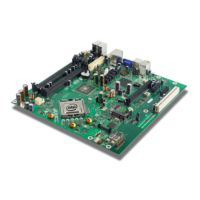LGA775 Socket Heatsink Loading
48 Thermal and Mechanical Design Guidelines
5.2.3.1 Tubing Material Selection
Tubing material selection requires balancing several different criteria. The parameters
that were considered were cost, flexibility, flammability and vapor transmissibility.
Three different types of tubing materials were tested for liquid loss by connecting a
know length of tubing to the ALCT pump and measuring the assembly weight prior to
the start and periodically during the test to quantify the loss. The liquid evaporation
and migration of vapor through the plastic walls to atmosphere is the mode of liquid
loss that is affected by the internal structure of plastic and its wall thickness. The
pumps were run at 1450 RPM and T
LIQUID
was maintained at 50 ºC. An extremely
accurate scale is required to measure the weekly losses that allow for the calculation
of a loss rate.
The results for 3 different materials are summarized in
Table 7. The Norprene
®
tubing
configuration had the lowest loss rate of 0.25 grams/week and was chosen as the
tubing material for ALCT. Material parameters are 3/8” internal diameter and 5/8”
outer diameter (1/8” wall thickness).
Table 7. The Weekly Loss Rate of Different Tubing Materials
Tubing Material Loss Rate (grams/week)
Polyurethene 5.0
PVC 1.2
Norprene
®
0.25
5.2.3.2 Reservoir Sizing
The liquid loss through vapor migration through the tubing walls and joints can be
minimized but not eliminated as shown by the relatively impermeable material of
Norprene
®
rubber. The metal tubing was not a good option due to the flexibility
needed for the assembly of the solution inside of a chassis. The effect of liquid loss
can be mitigated at least for a reasonable operational life of the solution by providing
a liquid reservoir. A continuous operation test at 50 ºC and 1450 RPM was conducted
with assembly mass monitored every week to identify weekly mass loss rate. The
assembly mass loss data with 3 samples for 7 weeks duration is shown in
Figure 13.
The data shows that average loss rate was 0.25-0.30 grams/week and is reasonably
consistent for 3 samples. The reservoir size of 38 milli-liters (38 grams for water) was
chosen to provide 152 weeks (approximately 3 years) of operational life. The pump is
expected to have additional resilience to liquid loss prior to significant impact to
thermal performance.

